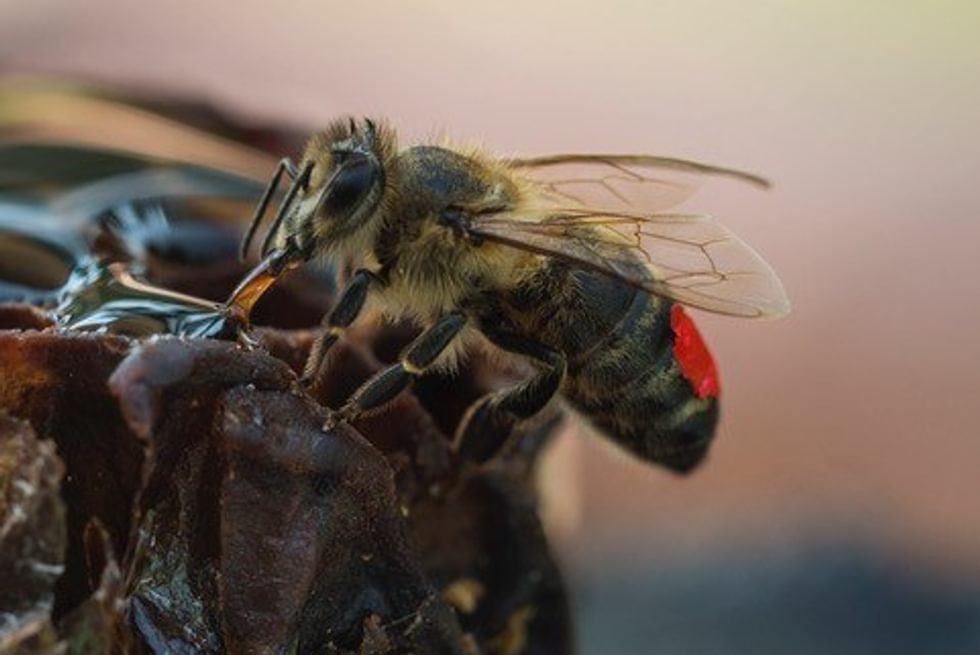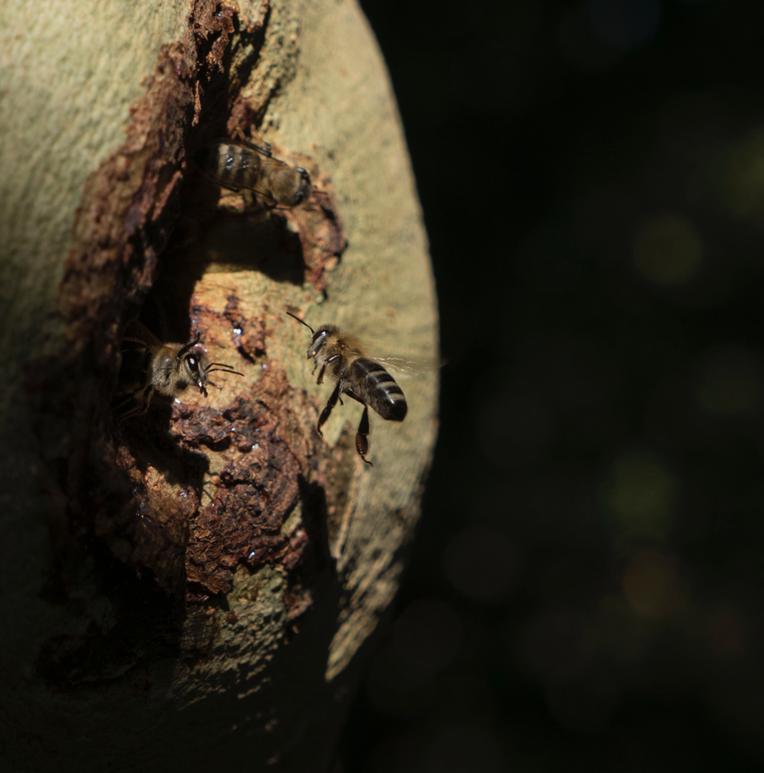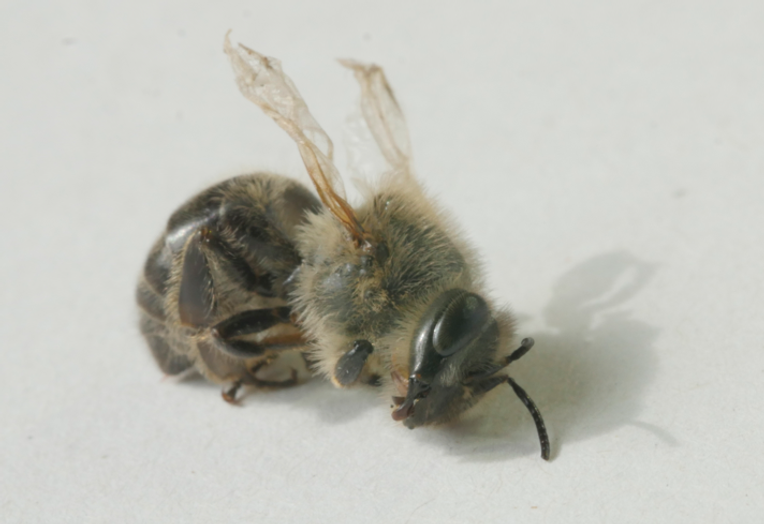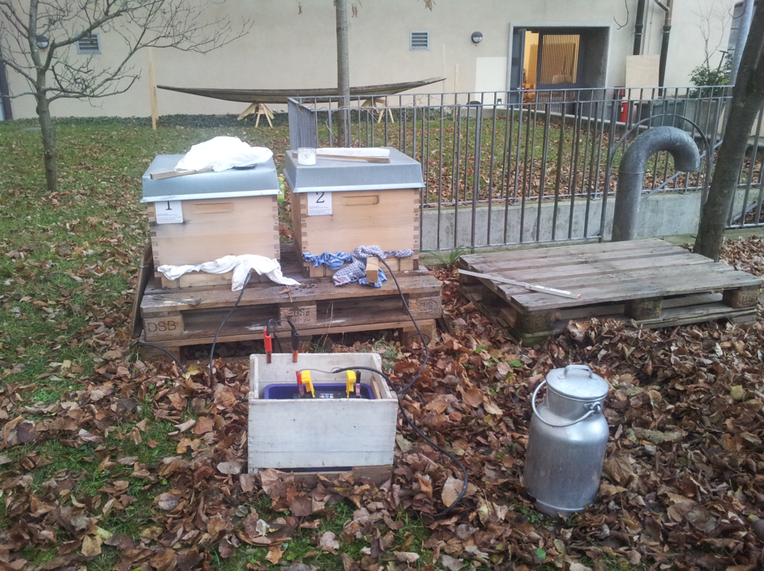Ecologizing Honeybee Care: Multi-Species-Bodies and Trust in the Varroa Pandemic
From the Series: Multispecies Care in the Sixth Extinction
From the Series: Multispecies Care in the Sixth Extinction


One morning in August 2019, a colleague and I went to an old Platanus tree growing in Munich, southern Germany. High above us in an old woodpecker’s hole, a colony of honeybees (Apis mellifera) was living without any interference or care by human beekeepers. We shot a rope over a strong branch in the crown to climb up and check the conditions of the colony. My colleague Sebastian was monitoring a good dozen independently living colonies in Munich as a citizen scientist. I had joined him to learn more about the honeybees’ lives outside the human honey and pollination business with its veterinary healthcare regimes. A bit later, as I was hanging in the rope up in the tree, taking a wax sample and some photos of worker bees bringing in pollen, Sebastian found a dead bee lying on the ground below the nest entrance. The corpse had crippled wings, a symptom of a deformed wing virus (Iflaviridae) and a sign of “infestation” by a parasite—a little mite named Varroa destructor.

When Varroa arrived in Germany from South Asia in 1977 it spread quickly; beekeepers told me of how they had lost many colonies and no one knew what to do. Soon a commissioned network of apidologists and pharmacists established a biopolitical perspective on the problem framed by the modernist notion of technological and scientific control. In the following years, hive architectures were altered to enable easier testing of “infestation rates” and obligatory medication was developed. The synthetic acaricides and organic acids enabled the beekeepers’ vocation but also held them responsible for containing the spread of mites within a region. Today, some forty years after the Varroa’s migration, all conventional and organic beekeeping in Europe is based on comprehensive chemical treatment. The number of annual treatments has tripled over the decades and I notice a growing dissatisfaction among beekeepers with the dynamic of the human-bee-mite relationship. Now, there is a specialty in this relationship that helps to open up our understanding of care.
Keepers relate to their bees as individual super-organisms. It is the colony as a whole whose reliable character they get to know over the years. It is the body of the colony that they care for when it is sick, and mourn when it is lost; the colony maintains a mammal-like body temperature over 35°C and gives birth to just one or two swarms a year. Learning to “keep” and care for bees myself meant adapting and becoming attuned to this intriguing simultaneity of scales, a picture puzzle of hybrid invertebrate-mammal corporeality that disperses into the environment during the day and reassembles in the night and the long winters.

That in mind, let’s look again at Varroa: scientists define the little mite as an ectoparasite that acts on the surface of another species’s body, in our case, that of the individual bee. Beekeepers would not use that terminology but they do relate to the mite as an endoparasite living within the body of a super-organism that was supposed to consist of bees alone. Being responsible to treat Varroa I had to visit my apiary regularly to evaporate oxalic acid into the hives and to wait for the dead mites to rain down over the next days; a practice of purifying the social body of a species both technically and ontologically.

Not all of Europe went along with the regime of medical control. In the very northwest of Wales lies a region called Gwynedd. Beekeepers here first found mites in 1997 and began using chemical treatment, but they were not convinced of the medicalized approach. Gwynedd’s official bee inspector, Pete Haywood, told me that they lost some colonies and the rest “looked a bit rough for a bit,” but within a few years honeybees and mites somehow co-adapted. He and his colleagues supported their bees by distancing the colonies to each other to decrease transmission, troubling them as little as possible, and trusting in their ability to take care of themselves. Proof of survivor colonies from other countries have since spread and apian science has become interested in the mechanisms behind this survival (Locke 2016; Seeley 2016). “Western” honeybees were found to be capable of gaining complex knowledge about the mites living among and within them. Under selective pressure by the mites, some colonies have learned how to disturb mites’ brood cycles, how to groom each other for mites, and even how to attack them.
Behandlungsfreie Imkerei in Gwynedd, Wales / Treatment free beekeeping in Gwynedd, Wales from primate visions on Vimeo.
Growing interest in apian “survivors” resonates with growing awareness of honeybee symbionts, such as the mite-eating book scorpion (Chelifer cancroides), that dwelled inside beehives before the turn to routine medication. Until today, human carework has concentrated on cleansing the hive of most organisms except the bees, in an act of bodily and conceptual hygiene. In the black box (Latour 1993) of a technological hygienic fix, mites, pseudo-scorpions, beneficial fungi, and other microbes were muted and hidden, or neglected, in María Puig de la Bellacasa’s (2011) sense. With survivors and symbionts speaking up, the modernist idea of the controllably pure (super-)organism becomes ecologized (Latour 2013): it is shifting toward an emergent and dynamic multi-species-body, concomitant with a range of multi-species care practices. It is a shift we also find in post-humanist concepts of our own multi-species-bodies, equally permeable, merging into each other (Haraway 2008) and co-dependent when perceived on the scale of the microbiome. A troubling experience, especially in the current COVID-19 pandemic, but a clear call to build a care- and trustful relationship with our bodily sociality.
Tim Ingold (2000, 69, 75) describes trust as the “peculiar combination of autonomy and dependency” defining indigenous hunter-prey relations in opposition to the domination in livestock management. Now, care as trust is not a Garden of Eden fantasy; built on a new awareness of ecologized bodily-social formations, it involves dissent and practices such as killing, containment, and hygiene. Sometimes it involves mourning for the once stable but now lost formation of a multi-species-body that was collectively cared for.
The colony in the old Platanus tree did not survive. A pity, imagining the suffering of all involved species, and knowing that their chances for co-adaptation were complicated by forty years of chemical, and some hundred years of modernist, purification. Our monitoring efforts, however, developed into a nationwide citizen science project, the BEEtree-Monitor. Although the engaged beekeepers and scientists must often report colonies’ perishing over winter, the imaginary of a pure domesticated species has given way to an ecologized understanding. This offers the hope of a slow change in beekeepers’ care practices, from domination to trust.
Haraway, Donna J. 2008. When Species Meet. Minneapolis: University of Minnesota Press.
Ingold, Tim. 2000. The Perception of the Environment: Essays on Livelihood, Dwelling and Skill. London: Routledge.
Latour, Bruno. 1993. We Have Never Been Modern. Translated by Catherine Porter. Cambridge, Mass.: Harvard University Press.
———. 2013. “Biography of an Inquiry: On a Book about Modes of Existence.” Social Studies of Science 43, no. 2: 287–301.
Locke, Barbara. 2016. “Natural Varroa Mite-Surviving Apis Mellifera Honeybee Populations.” Apidologie 47: 467–82.
Puig de la Bellacasa, María. 2011. “Matters of Care in Technoscience: Assembling Neglected Things.” Social Studies of Science 41, no. 1: 85–106.
Seeley, Thomas D. 2016. “How Honeybee Colonies Survive in the Wild: Testing the Importance of Small Nests and Frequent Swarming.” PloS ONE 11, no 3: e0150362.